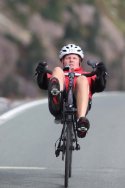I see a number of posts where it appears that folks are using about the same gearing on their Cruzbike as they did on their uprights.
I have a friend with years of recumbent (non-Cruzbike) experience. He's trying to convince me that I need gearing close to 19-20 gear inches for steep climbs, which would require 26 front / 36 back gearing. My current setup has a low gear of 30 front / 32 rear
I live in the Pacific Northwest. Bike rides with 10,000' and more climbing aren't that unusual, and there are local pitches that reach 20%.
My current lowest gear, slightly lower than my uprights, is 30 / 32, and I have a crank I could install that would give me 26 / 32.
For those of you riding hills (and mountains) - did you find that you needed lower gears on the S40? If so, how much lower than your upright?
thanks!
There are several variables here that will make one rider's preferred gear selection less than ideal for another rider. First is probably fitness, closely followed by a rider's mental attitude toward climbing (some just don't like climbing, so their gear selection might lean toward flatter riding). As a flyweight, climbing has always been my thing, and I believe that my last DF road bike (eight years ago) had a 39/27 climbing gear on a 10-speed drivetrain. I bumped along just fine for years on my V20 and S30 with a 36/28 climbing gear on an 11-speed drivetrain, until I hit a route with sustained 15%+ stretches. Wheel slip wasn't an issue, but I needed one...more...gear. Now I'm up to a 36/30 climbing gear (as well as a 52t chainring, up from a 50t), and appreciate the difference, while knowing that I don't need a 32t climber, yet (choosing a cassette cluster is a balancing act for me: I need low enough gears for the climbing that I do, but also like tight gear ratios for flatland riding).
Then you throw in the question of crank arm length, and the discussion shifts again. I'm using 160mm cranks. Put my same 52/36, 11-30 gearing onto 150mm or 170mm cranks, and the pedaling dynamics and demands will be different for each.
In short, absolutely look around at what other people are using, but be ready for the road (and your knees) to tell you what gearing is right for you.
A closing observation: my V20 and V20c have had the least wheel slip, while my S40, when I owned it, had the most, with the S30, which I still have, coming right in between the two, which I guess makes sense. I'll leave it to one of the engineer types to explain why seat recline might affect wheel slip. The difference in front-end grip between the V and the S40 isn't huge, but I did find it noticeable and consistent. When grades pitched up in front of the S40, I tended to gear down and spin about one cog easier than I would on the V, to lower the amount of force being applied to the pedals. On the V, my legs and lungs tend to be the limiter well before wheel slip. But here again, everything is personal to the rider. At 130lbs (59kg), I don't have a lot of weight to put on that front wheel. A heavier rider on the same bike might have a different experience.
Where a new CB rider starts with gearing choice probably won't be where he or she stays.



